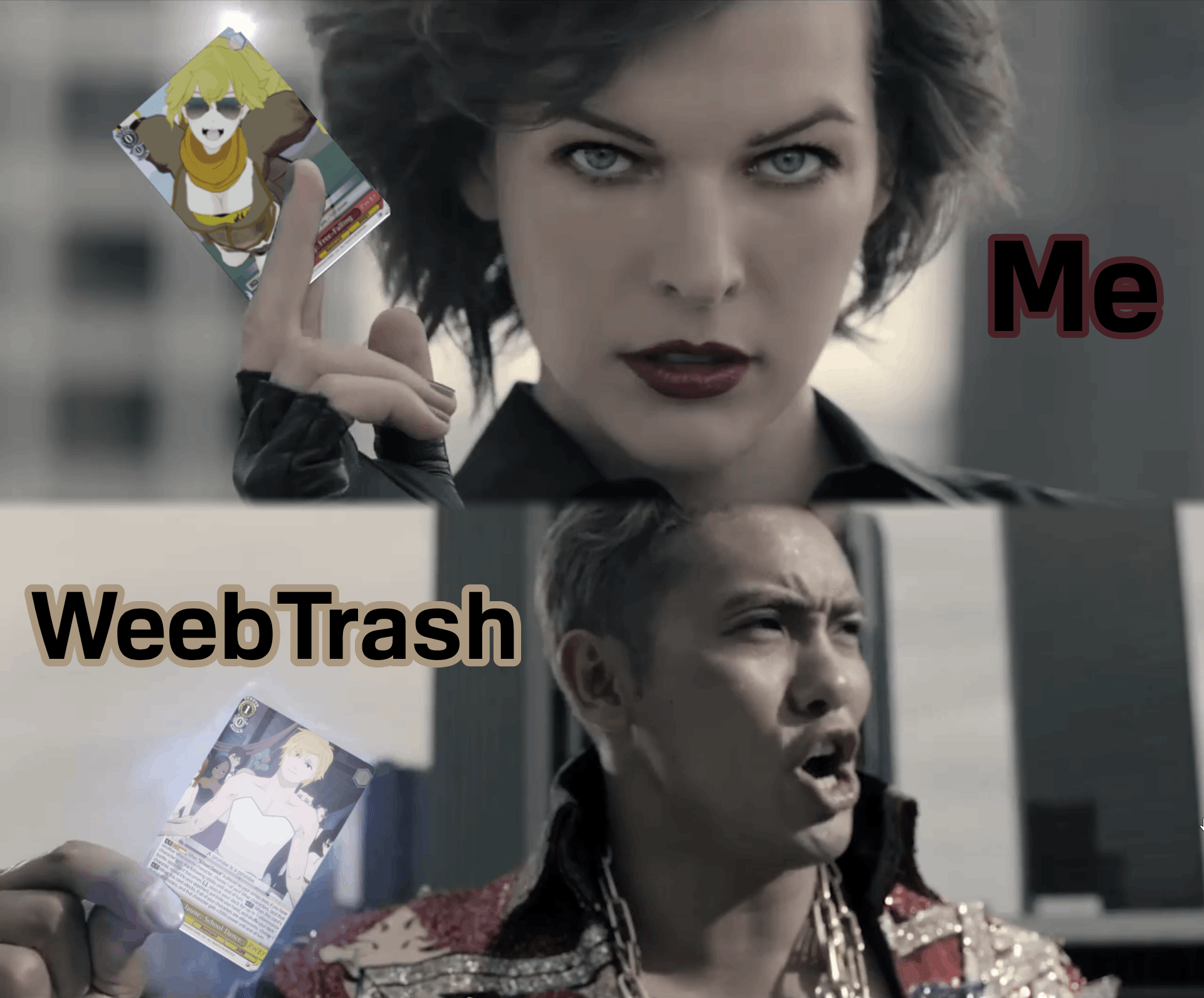On July 4th 2021, a card game with a peculiar name announced that they’re releasing a new set all about RWBY. Five and a half months later we can finally get our hands on it – the Weiẞ Schwarz RWBY set is out and I bought it so you wouldn’t have to. Now, was it worth it?
If you want a quick answer, feel free to scroll down, but I’d recommend you continue to read because the final verdict is a bit complicated. First of all, some context about the game, how I’ll be evaluating the cards I bought.
What is Weiẞ Schwarz?
It’s a physical trading card game (TCG) by the company Bushiroad first released in March 2008. Bushiroad is a well-known company in the TCG genre, as they’re also the creators of Future Card Buddyfight and Cardfight!! Vanguard, two other games with… interesting names, the latter of which is pretty popular and even has an anime and manga released. Oh and to keep the tradition of fighting (Bushi does mean ‘warrior’ in Japanese), they also own the biggest Japanese pro-wrestling company New Japan Pro Wrestling.
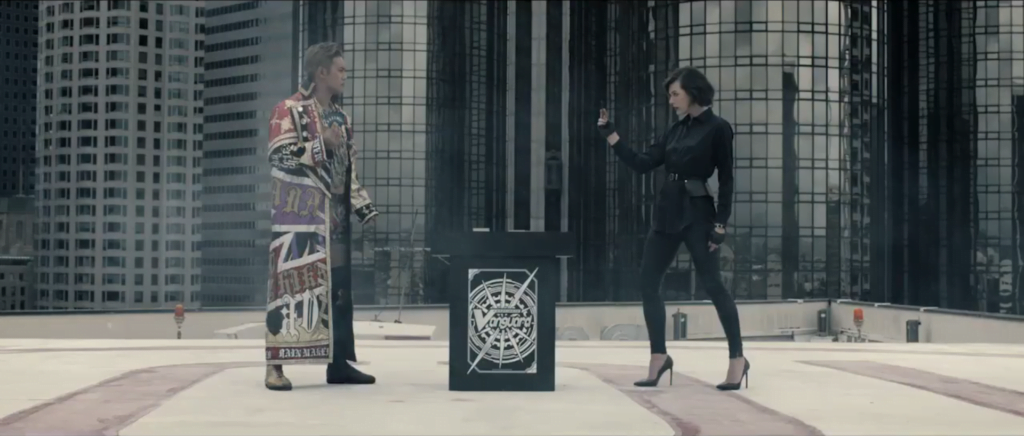
You might not have heard of Weiẞ Schwarz before, and it’s understandable. The game is much more popular in Japan than outside of it, and even then, it’s not even in the top 5 of the most played trading card games there. Worldwide, according to ICv2, in 2020 it was the 8th most popular TCG.

While Weiẞ Schwarz is definitely less popular than Japanese pro-wrestling or it’s direct competitor with two exclamation points (one more than Yu-Gi-Oh!, but equally annoying to type out) it does stand out from the market of confusedly named Japanese card games. This one’s unique selling point is all of the card sets released are about various anime, cartoon or comic properties. They’ve had IPs like Kaguya-Sama: Love is War, Date a Live, Re:ZERO, Fate/stay Night, Sword Art Online and That Time I Got Reincarnated as a Slime be translated into cards and decks for their game. Oh, that’s just a few of the 2021 sets. They’ve also had juggernauts like Konosuba, Adventure Time, Jojo’s Bizarre Adventure, Persona, Attack on Titan, Idolmaster, Love Live!, Madoka Magica, Hatsune Miku and freaking Batman released earlier. If those names didn’t raise an eyebrow (or if you prefer 3D), their latest set is the VTuber conglomerate Hololive. It’s actually fairly exciting to see RWBY being immortalized among the titans of animated shows. After a bit of research, however, it’s actually not that unbelievable…

Why did they launch a RWBY set?
Those of you with a keen eye might have noticed that the vast majority of properties named are from Japan, except Adventure Time and Batman. Actually, it was Batman Ninja that was released as a card set, and that is a Japanese animated film. But they’re both important because they belong to Warner Brothers. Well, Adventure Time belongs to Cartoon Network, which belong to WB, but that’s not too different from RWBY belonging to RoosterTeeth, which is owned by WarnerMedia as well. Basically, Bushiroad and WarnerMedia already had a partnership from before and Batman Ninja was the first-ever English-only Weiẞ Schwarz set. It’s not a huge surprise, then, that another western-focused Warner property would be used to further expand Weiẞ Schwarz outside Japan.
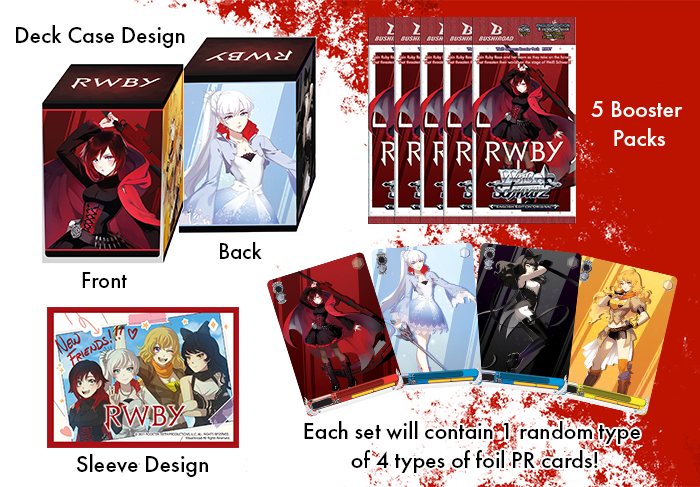
What are your qualifications to talk about it?
Outside the fact that I’m a RWBY fan, I have a long history with card games. I’ve actively played or at least dabbled in games like Yu-Gi-Oh!, Pokémon, Android: Netrunner, Star Wars: Destiny, Game of Thrones, Keyforge and probably some other dead Fantasy Flight card games. From a digital standpoint, I was neck-deep in games like Magic Arena, Hearthstone, Elder Scrolls: Legends and Legends of Runeterra. I used to play Magic: the Gathering competitively and was a judge for the game, for all that’s worth. I hope that’s sufficient proof that I know my way around a card game, at least enough for an article.
My friend and test subject, WeebTrash, assisted me with my research by playing several games with me. I chose him in particular for our similar experience in card games, as well as his massive distaste for anything RWBY related – he’s always properly motivated to destroy my RWBY deck and will try his hardest to win.
What did you buy?
I bought a RWBY Trial+ Deck, which is similar to a starter deck in other games, but it contains cards not found in boosters, and a supply set, the contents of which you can see above. To coerce WeebTrash to play, I also bought a Trial+ Deck of a show we both greatly enjoy – Mob Psycho 100. All of this, along with shipping, cost me a little over $100 USD, which isn’t exactly cheap for many of us. More on the value later.
The Trial+ Decks are 50 cards each, all of which are unique and brand-new to that deck. This is pretty smart, as the game incentivizes you to just buy the deck without worrying you might get useless duplicates of the cards inside from booster packs. The decks are definitely not meant for competitive play and the game even says so itself – the instructional booklet recommends you to buy a duplicate Trial+ deck so you could replace some of the worse cards with better ones. This is a tactic that’s used in a lot of card games, but, like the others, it’s generally not the best value. If you want to build a good deck you’ll end up buying specifically the cards you need (singles) or open hundreds of expensive booster packs.
How does it look?
If you’re only interested in the cards as a form of RWBY merchandise, the appearance of the cards is probably on top of your list. The cards are designed in a sleek, modern look, even though the text can be a little small. Still, the game knows its audience well – the vast majority of card space is occupied by card art, which a lot of players will be most interested by. Here’s a few examples of the cards:
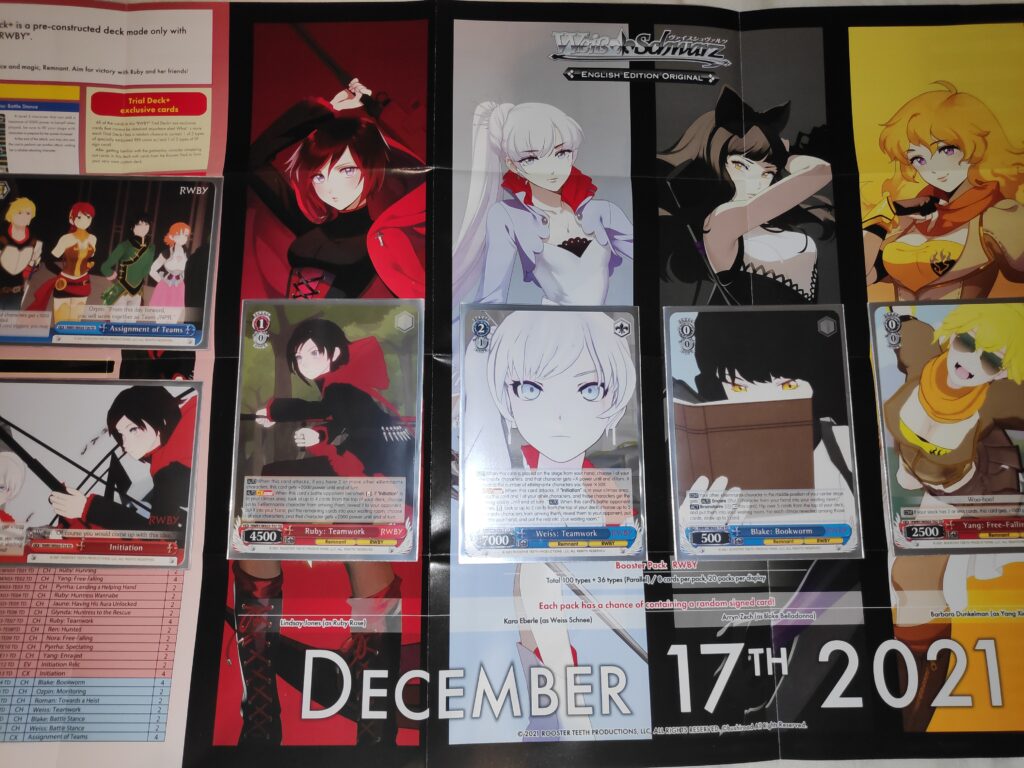
There’s a couple of things noticeable immediately – first, the art is all screenshots from the show. Second, all of those screenshots are from Volume 1. Yeah, the very first one. There’s a Pyrrha card that even has the shadow people. The booster packs, thankfully, offered some variety – they included scenes and characters from Volumes 1-3. All of them were screenshots too, except for the promo cards – those lift art from other sources, like promotional art for the video game Grimm Eclipse. In short, if you were expecting new licensed RWBY artwork, this isn’t it. This is seemingly the case for other sets as well – our Mob Psycho 100 set also had only screenshots from the show as the artwork.
As for limiting the card set to only the first 3 Volumes – that’s fairly expected. RoosterTeeth is much more stingy with adapting the later volumes into anything – the board game Combat Ready, the aforementioned Grimm Eclipse, the official Manga and so on are all set in the first three Volumes and only contain things like a minor villain or a set of costumes to remind us of later Volumes of the show. Hopefully, if the Weiẞ Schwarz RWBY set is popular enough, there will be a second set, centered around the later Volumes.
How does it play?
This part is really lengthy. If you don’t care about the gameplay at all, feel free to skip to the conclusion. If you plan on ever playing Weiẞ Schwarz, this might be pretty informative.
First, a quick overview of the rules: the goal of the game is to get your opponent to Level 4, by attacking them with your Characters. Damage from Characters, Events and other means is calculated by the Clock – you add the top card of your deck to the Clock for each point of damage you take. Once it reaches 7 cards, the Clock resets to 0 and you gain a Level. Some stronger cards require you to be Level 1, 2 or even 3, which means the closer to losing you are, the stronger cards you can play. There is a resource called Stock, which is used to play some stronger cards or effects, or to prevent a card from being beaten in combat. You get 1 Stock for each attack. There are 3 different ways of attacking – attacking an opposing Character directly in front of your own, attacking the opponent directly while avoiding the opposing Character, or attacking with a stronger direct attack if there is no opposition in front of your Character. Finally, there are Climax cards that boost your team for a turn or prevent damage if they’re revealed when you’re adding cards to the Clock from an attack.
That’s basically the entire ruleset summed up and, as you can see, it’s not that complicated, especially when compared to other TCGs we’ve played. Weiẞ Schwarz feels intuitive for the most part, and even some more elaborate mechanics like Triggers that occur whenever you attack or the Clock Phase that allows you to add a card to your Clock to draw two others (dealing damage to yourself for card advantage) were eventually learned and used in our first game fairly quickly. Perhaps the rules didn’t feel difficult since we are used to TCGs, so if you’re completely new to card games there might be some trouble at first. Every Trial+ deck does come with a rules-explaining booklet and a playmat to help you in your first games. The playmat in particular is helpful – there are quite a few different areas on the field you need to keep track of, and, unlike most TCGs, where you place and move your Characters matters quite a lot. Of course, if I planned to play more, the playmat would eventually be discarded and be replaced by a regular TCG playmat, which, for those unfamiliar, is basically an oversized mousepad.
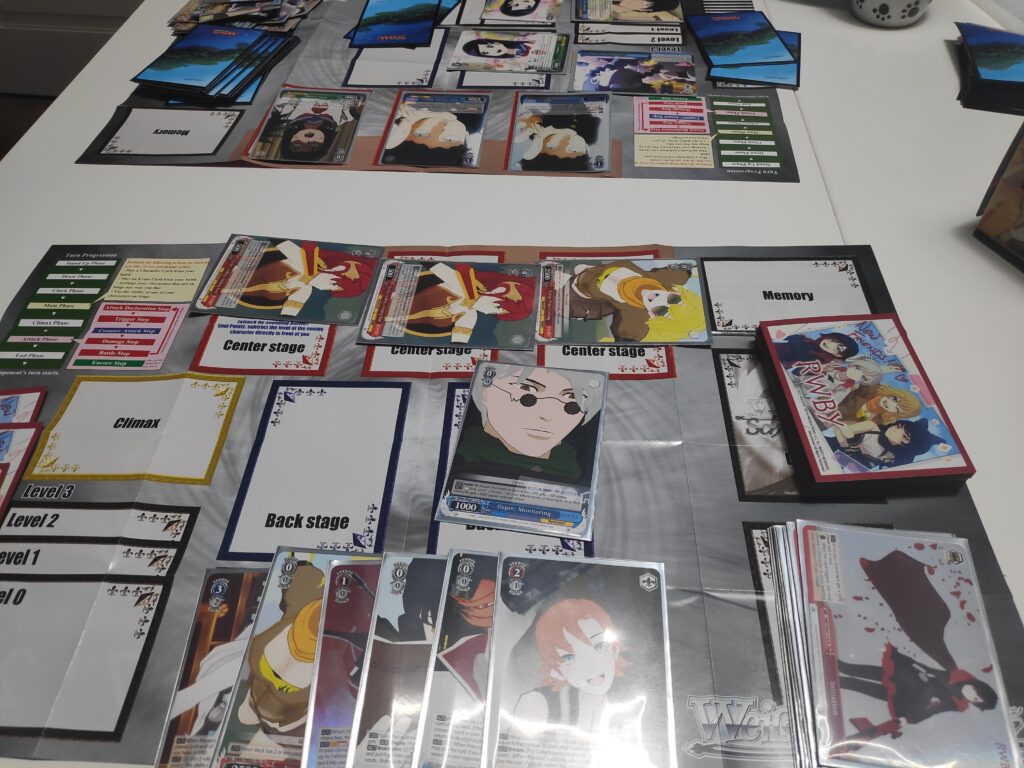
The idea that you get increasingly stronger the closer to defeat you are is a really cool one – it’s a over-time progression mechanic that also inherently allows for glorious comebacks. It also opens some great decision-making, especially for the attacking player: “do I attack the opponent with my weak Character directly? It will likely deal some damage, but also put the opponent into Level 3, allowing them to play their finishers.” In a similar vein, the game uses Levels to prevent players from playing their strongest cards immediately from turn 1. This sort of mechanic does mitigate the “mana screw” problem that Magic players know all too well, and at the same time it doesn’t rely on specific cards to level up, unlike Pokémon. However, you still can draw a bunch of Level 2s and 3s even after a mulligan, and be at the mercy of your opponents attacks to Level you up, but the fact that you can draw 3 cards every turn (even in the very first one!) does help out a lot not to feel like the cards screwed you before the game even began.
Just like Pokémon, Weiẞ Schwarz doesn’t limit how many Characters you can play in a turn and they can attack the turn they are played. Unlike Pokémon, however, you can attack with more than one Character in a turn. Combine that with the heavy amount of card drawing the game features and you end up with usually all three Characters attacking each turn. Attacking is encouraged, even though doing damage to your opponent does make them stronger. Each attack builds your Stock resource and all three attack types intend (and usually do) deal direct damage to your opponent. In one game I used a bunch of Level 0s to attack straight into Level 2s and 3s – even though they obviously lost their fights, they still dealt enough direct damage to close out the game. A lot of cards also have “When attacking” or “Once per turn” effects that significantly increase their attack power – I noticed that turn players have a LOT of advantage in combat and usually can easily beat out opposing Characters that are way more powerful just by using those effects and Climax cards. To add to that, there is very little you can do when its not your turn – you’re practically limited to a single card you may use to increase the attack of one of your creatures, but in all of our games that happened only once. Finally, another quirk of this game is the fact that there are no alternate win conditions – in most TCGs you lose when your deck runs out of cards and some decks cunningly utilize this to win without damage. Here, however, you simply shuffle your discarded cards, the Waiting Room, as your new deck and put a single card onto the Clock – it’s so common that it happens basically every game. To summarize – in Weiẞ Schwarz, you can draw and play a lot of Characters every turn, all of their attacks deal direct damage and generate a useful resource, the attacking players have a distinct power advantage while the defense basically wait for their turn and you can only win by damaging the opponent.
This results in a very swingy game where each player usually takes the upper hand every other turn. The turns when you are attacking make you feel unstoppable, but its balanced by the fear and helplessness you go through when it’s your opponent’s turn. Keep in mind that this was with our simple Trial+ decks and the competitive scene might be different.
WeebTrash felt a bit different about the game – he thought that while Weiẞ Schwarz did have unique mechanics, it didn’t exactly form into a cohesive whole. The decks also didn’t feel very balanced, as he couldn’t win against my RWBY Trial+ deck once. In the end, WeebTrash was most disappointed that all artwork was just screenshots from the shows – Mob cards in particular, as the rare versions of the same card were just slightly zoomed out when compared to a common version. In his words – if you aren’t a massive fan of the properties, there’s little to keep your interest. He said that he won’t be going out of his way to play the game after tonight.
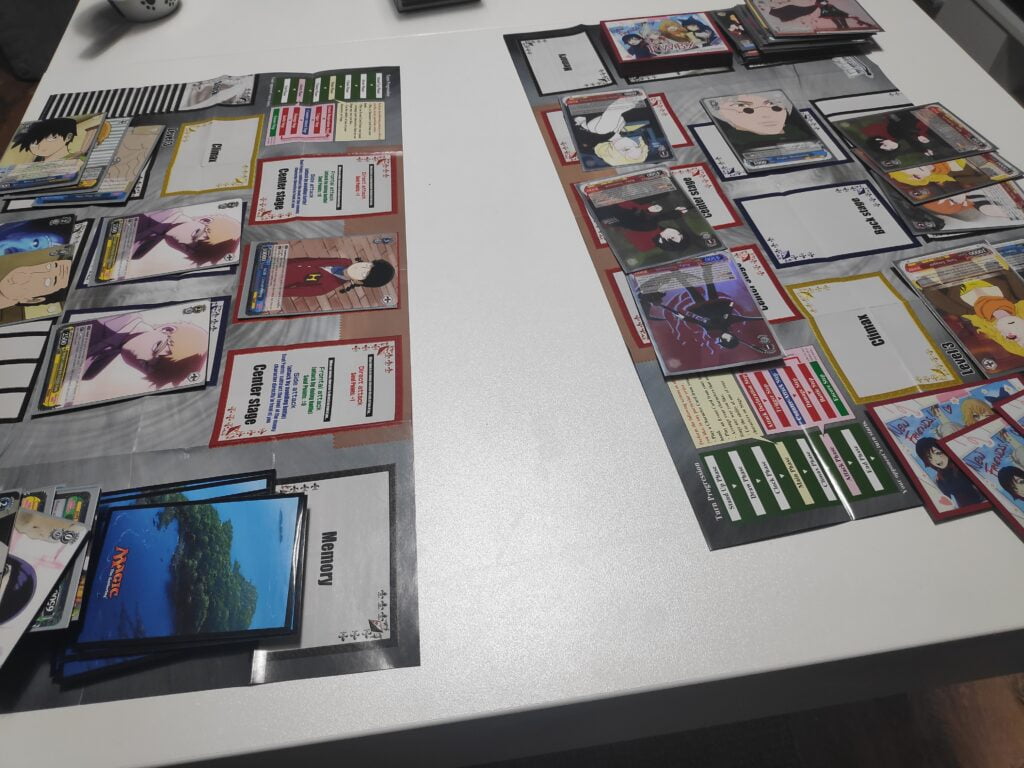
What’s the pricing of the cards?
The price of the products varies from place to place, but I found that Trial+ decks (the ones you need to start playing the game) range from $15 to $25 USD, more if the set isn’t new like RWBY. The supply sets, which include an actually neat deck box and average-quality printed sleeves with five booster packs and a single promo card go from $40 to $50 and a single booster is $4.5 to $5. Finally, a booster box, containing 20 packs, is from $65 to $80. Judging by these prices, it seems I definitely payed on the higher-end of the spectrum, but I digress. What’s more interesting is the average price of a single card…
You see, the Trial+ decks, that come with 50 cards not found in boosters, are actually a great value and if you’re interested in a couple of casual matches with friends, that’s a good way to go. Unfortunately, the rest of the products seems awfully expensive – booster packs and supply sets in particular. For the latter, you’re paying about $25 just for a deckbox and a pack of card sleeves – a $10 value at best. They do look nice, but it’s clear that this is where the big profit margin comes from. As for the boosters – they are 8 cards each, but priced equally (or more) than boosters for games like Magic or Pokémon, which have 16 and 10 card boosters respectively. If we factor in booster boxes, the price for Weiẞ Schwarz does normalize a little bit. Here’s a little comparison between the top 4 most sold card games on tcgplayer.com:
| Name | Cards in Booster pack | Packs in Booster box | Price of Booster box | Price/Booster | Price/Card |
| Magic: the Gathering | 16 | 36 | ~$110 | ~$3 | ~$0.19 |
| Yu-Gi-Oh! | 7 | 24 | ~$70 | ~$2.9 | ~$0.41 |
| Pokémon | 10 | 36 | ~$120 | ~$3.3 | ~$0.33 |
| Weiẞ Schwarz | 8 | 20 | ~$65 | ~$3.25 | ~$0.40 |
The thing with booster boxes, though, is that you want to have more boosters in a box, rather than less – every single booster has a single rare card. Even though Yu-Gi-Oh! costs a little bit more/card, for example, the fact that you get four more boosters in a box means you get four more rare cards, which are the only ones that actually hold any value. Even if a common card is potentially incredible competitively, it will usually go for pennies just because of the insane amount of packs being opened. While putting the data into the table made me feel much better about the purchase (I thought that the game was much more expensive than it turned out), it’s high price, especially compared to Magic is two-fold. First – it’s a Japan-centered game. All three games in the table below Magic share that distinction and the costs associated with that. Second – the signature cards.
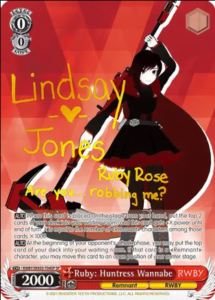
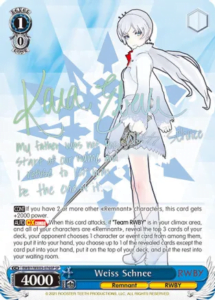
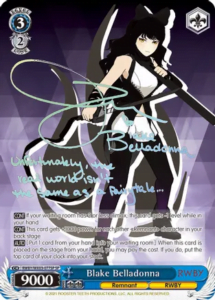
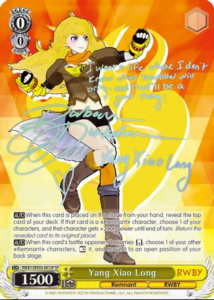
Out of the entire RWBY set, these cards are practically the only ones that hold any significant monetary value. Disregarding signature and promo cards, only 3 cards out of the entire RWBY set are currently being sold for over $20, 11 total for over $10. The signature ones? The cheapest one is $200, some going for as much as $300. That’s a massive price difference and also the reason for the expensive boosters. Turns out a case of 16 booster boxes (with a whopping $1,200 USD price) guarantees 2 of these signed cards – meaning that up half of the value of it is inside two cards, while the rest is shared by 2558 others. We’re not talking about the 1% here, we’re talking about the 0.1% of wealth distribution! People hunting for a complete set or these particular signed cards will end up with a LOT of duplicate common, uncommon, rare and double rare cards, which end up being sold for cents. On the bright side, if you do want to build your dream RWBY deck from single cards, a non-shiny version of it will cost you a fraction of what a competitive Magic or Yu-Gi-Oh! deck would. I can’t vouch for competitive viability of this RWBY set, though, so make sure you research it before plunging into the tournament scene right off the bat. Recent tournaments (before the release of this set) feature a lot of Date a Live and Sword Art Online decks, so you may want to look into those if you’re a fan, but availability of older sets is a massive issue in Weiẞ Schwarz so don’t get your hopes up too much.
Is it worth the purchase?
It all depends on what do you want from this set or the game itself.
- If you’re just looking for cool/unique merch of the show, a Trial+ deck is your best bet. It’s affordable and the promo cards look really cool;
- If you’re looking for a new TCG to sink your teeth in, Weiẞ Schwarz is deep enough to be fun for a while. It’s biggest downside as a TCG is it’s low popularity. Before committing, make sure to research if the area around you has an active community. A quick Google search, a question in the subreddit or a browse through the official list of stores will help. Hopefully this new English-only set will attract more fans outside of Japan. And hey, you might find friends who are also fans of RWBY through this game!;
- If you’re looking for cool artwork you could collect or display – you might want to give this a pass. Pretty much all of the artwork is just screenshots from the show, which you can display much better yourself in a form of a poster;
- If you’re looking for signed/unique memorabilia – avoid this game. The signed cards are extremely expensive (and they’re photocopies of an original signed card anyway). It’d be much easier and cheaper getting a photo signed in a (virtual) convention;
As for personal anecdotes, while WeebTrash wasn’t exactly impressed with the game, I talked with a fellow RWBY fan BadLuckScorpion (BLS) on their opinion of the RWBY set and the game. As a fan of the show and shiny things, they bought a Trial+ deck and a booster box. BLS knew that the art is just fancy screenshots, but also that it’s the whole point of Weiß Schwarz – reliving moments from a show someone likes. BLS doesn’t plan on buying more than they’ve already ordered from this set, but would be glad to buy more cards if they released a new RWBY set based on later volumes. Overall, BLS was satisfied with what they’ve got, even if they didn’t pull that one Qrow card they wanted (though they did get cool Salem, Ruby, Cinder and JNPR dancing cards).
Considering me and BadLuckScorpion fall into the first two categories in the above list, it’s fairly clear why were overall satisfied, but not too ecstatic about our purchase. Meanwhile WeebTrash, who’d fall in line for the second and third categories, was fairly disappointed, which too is perfectly understandable. Overall it seems that you should buy these cards if you definitely know where you stand as a RWBY and trading card game fan. Therefore, I can only recommend the RWBY Weiß Schwarz cards to a very specific audience of both RWBY and card game fans. Still, getting a couple of Trial+ decks to play with a friend/partner for a few afternoons or a booster box to satisfy your gambling urges isn’t the worst thing you could do with your money. That’d probably be buying NFTs.
Update: the fifth and sixth paragraph were updated with corrected information. Thanks to /u/SoulGemWeiss for pointing it out!

